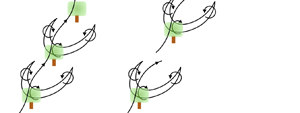Article contents
Surface layer response to heterogeneous tree canopy distributions: roughness regime regulates secondary flow polarity
Published online by Cambridge University Press: 08 August 2022
Abstract

Large-eddy simulation was used to model turbulent atmospheric surface layer (ASL) flow over canopies composed of streamwise-aligned rows of synthetic trees of height,  $h$, and systematically arranged to quantify the response to variable streamwise spacing,
$h$, and systematically arranged to quantify the response to variable streamwise spacing,  $\delta _1$, and spanwise spacing,
$\delta _1$, and spanwise spacing,  $\delta _2$, between adjacent trees. The response to spanwise and streamwise heterogeneity has, indeed, been the topic of a sustained research effort: the former resulting in formation of Reynolds-averaged counter-rotating secondary cells, the latter associated with the
$\delta _2$, between adjacent trees. The response to spanwise and streamwise heterogeneity has, indeed, been the topic of a sustained research effort: the former resulting in formation of Reynolds-averaged counter-rotating secondary cells, the latter associated with the  $k$- and
$k$- and  $d$-type response. No study has addressed the confluence of both, and results herein show secondary flow polarity reversal across ‘critical’ values of
$d$-type response. No study has addressed the confluence of both, and results herein show secondary flow polarity reversal across ‘critical’ values of  $\delta _1$ and
$\delta _1$ and  $\delta _2$. For
$\delta _2$. For  $\delta _2/\delta \lesssim 1$ and
$\delta _2/\delta \lesssim 1$ and  $\gtrsim 2$, where
$\gtrsim 2$, where  $\delta$ is the flow depth, the counter-rotating secondary cells are aligned such that upwelling and downwelling, respectively, occurs above the elements. The streamwise spacing
$\delta$ is the flow depth, the counter-rotating secondary cells are aligned such that upwelling and downwelling, respectively, occurs above the elements. The streamwise spacing  $\delta _1$ regulates this transition, with secondary cell reversal occurring first for the largest
$\delta _1$ regulates this transition, with secondary cell reversal occurring first for the largest  $k$-type cases, as elevated turbulence production within the canopy necessitates entrainment of fluid from aloft. The results are interpreted through the lens of a benchmark prognostic closure for effective aerodynamic roughness,
$k$-type cases, as elevated turbulence production within the canopy necessitates entrainment of fluid from aloft. The results are interpreted through the lens of a benchmark prognostic closure for effective aerodynamic roughness,  $z_{0,{Eff.}} = \alpha \sigma _h$, where
$z_{0,{Eff.}} = \alpha \sigma _h$, where  $\alpha$ is a proportionality constant and
$\alpha$ is a proportionality constant and  $\sigma _h$ is height root mean square. We report
$\sigma _h$ is height root mean square. We report  $\alpha \approx 10^{-1}$, the value reported over many decades for a broad range of rough surfaces, for
$\alpha \approx 10^{-1}$, the value reported over many decades for a broad range of rough surfaces, for  $k$-type cases at small
$k$-type cases at small  $\delta _2$, whereas the transition to
$\delta _2$, whereas the transition to  $d$-type arrangements necessitates larger
$d$-type arrangements necessitates larger  $\delta _2$. Though preliminary, results highlight the non-trivial response to variation of streamwise and spanwise spacing.
$\delta _2$. Though preliminary, results highlight the non-trivial response to variation of streamwise and spanwise spacing.
JFM classification
Information
- Type
- JFM Papers
- Information
- Copyright
- © The Author(s), 2022. Published by Cambridge University Press
References
REFERENCES
- 5
- Cited by


